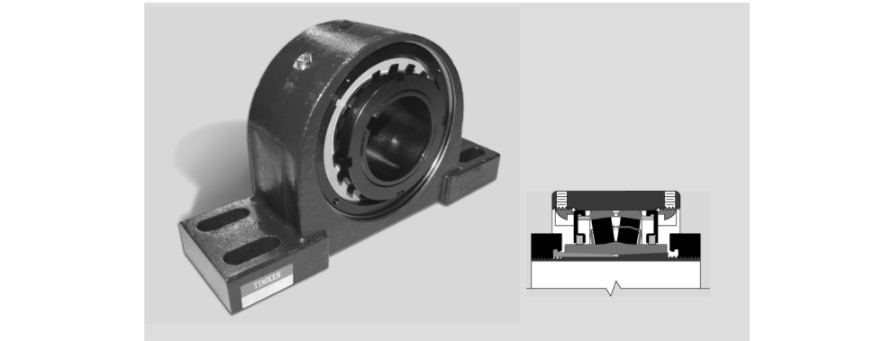Timken Spherical Roller Bearing Solid-Block Housed Unit Installation Guide - V-Lock Series
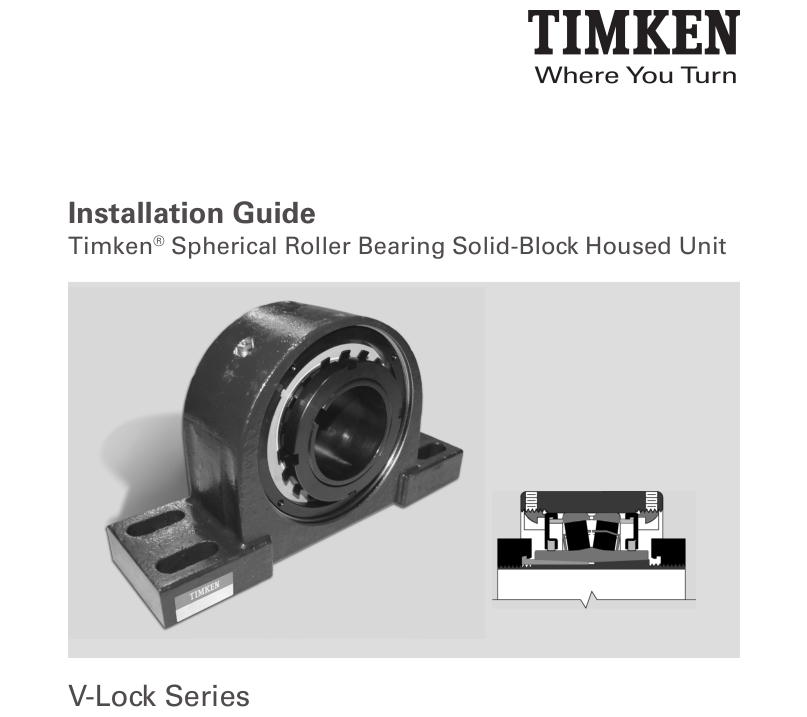
INSTALLATION GUIDEV-LOCK SERIES, SPHERICAL ROLLER BEARING SOLID-BLOCK HOUSED UNIT
Timken solid-block housed unit V-Lock bearings are easy to install and remove because of their unique adapters. Please complete the following steps to install and/or remove Timken steel housed unit V-Lock bearings. (Refer to fig. 1.)
INSTALLATION
- Ensure that the shaft is clean, free from nicks and burrs, straight and of proper diameter. See table 1 for recommended shaft tolerances. The housed unit should not be mounted on a worn section of the shaft. Use of shafts with hardness greater than Rc 45 will reduce the effectiveness of locking devices.
- If using an open-end cover, slide the open-end cover/seal combination into position on shaft.
- Remove the wedge assembly from the sleeve by unscrewing the wedge nut. See fig. 1.
- Clean oil off of the sleeve and wedge.
- Apply a thin oil film to the shaft only.
- For QV housed units:
- Slide the sleeve, non-threaded end first, into position on shaft.
- For QVV housed units:
- Make sure the sleeve nut is flush with the end of the sleeve.
- Slide the sleeve/nut assembly, nut end first, into position on the shaft.
- For QV housed units:
- Slide the housed unit into place over the sleeve.
- Loosely install the housed unit mounting bolts. Check the housed unit alignment (fig. 2). Verify mounting surfaces are in the same flat plane to help make sure good alignment is achieved. If shimming is required to minimize misalignment, use full shims across entire housing base where possible (fig. 2). Washers should be properly sized to bold diameter and should not be an SAE grade, which is smaller.
- Seat the sleeve as best as possible into mounted unit.
- Slide the wedge and wedge nut into the housed unit over the sleeve.
- Tighten the wedge assembly by turning the wedge nut clockwise until tight. Please note that it is designed to eliminate over-tightening.
- If installing double-nut housed unit, tighten the sleeve assembly by turning the sleeve nut clockwise until snug.
- Tighten both the wedge nut and sleeve nut set screws alternately according to table 2.
- Install the housed unit mounting bolts. Check the housed unit alignment. Verify mounting surfaces are in the same flat plane to help make sure good alignment is achieved. If shimming is required to minimize misalignment, use full shims across entire housing base where possible (fig. 2). The bolts then need to be alternately torqued securely to their mounting supports.
- Tighten the housed unit mounting bolts.
- If using covers:
- Make sure the mating surface of cover and retaining nut are clean and dry.
- If using a urethane cover, slightly roughen the mating surface of the cover.
- Place a 1 ⁄ 8 in. – 1 ⁄ 4 in. bead of polyurethane adhesive sealant on the mating surface of the cover.
- Align cover mounting holes with the mounting holes on the retaining housing nut (make sure that the grease fitting on the cover is accessible when doing so).
- Apply and tighten cover mounting hardware.
REMOVAL
- Remove covers, if applicable, by removing cover hardware and disengaging cover from housed unit retaining nut.
- Loosen the setscrews on the wedge nut.
- Turn the wedge nut counterclockwise to remove the wedge from the locked position.
- Completely remove the wedge/wedge nut assembly.
- For QV housed units:
- Remove the bearing and sleeve from the shaft.
- For QVV housed units:
- Loosen the setscrews on the sleeve nut.
- Turn the sleeve nut clockwise to un-seat the sleeve.
- Remove the bearing and sleeve/sleeve nut from the shaft.
- For QV housed units:
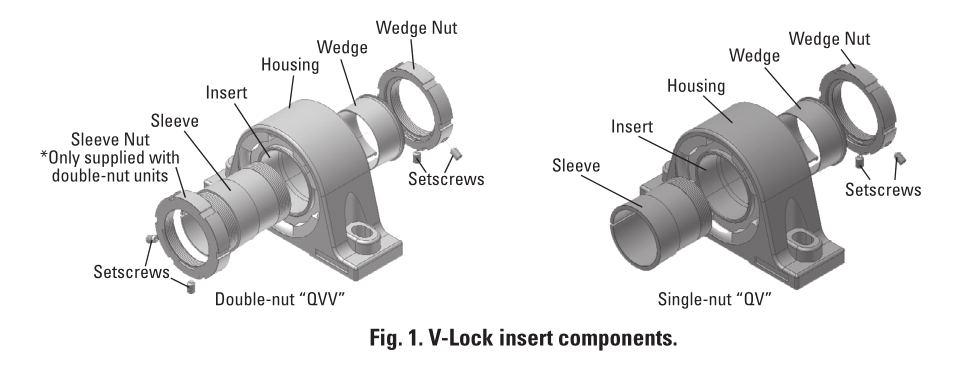
TABLE 1. RECOMMENDED SHAFT TOLERANCES
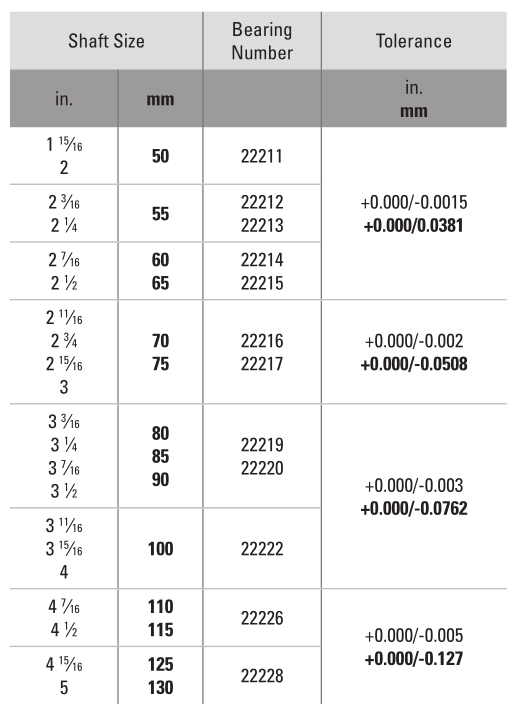
TABLE 2. SETSCREW TORQUE VALUES

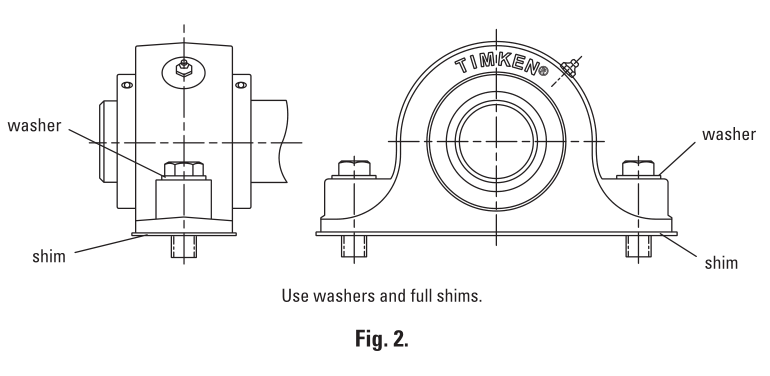
TABLE 3. RE-LUBRICATION INTERVALS

LUBRICATION
This information is to aid in the proper lubrication of Timken spherical roller bearing solid-block housed units for the majority of the applications. Housed units have been factory prelubricated with an NLGI No. 2 lithium-complex extreme-pressure synthetic grease that combines the benefits of wide operating temperatures and broad compatibility with varied materials. This grease offers excellent thermal stability through temperatures ranging from -40° to 177° C (-40° to 350° F). Housed units should be relubricated with this grease or one that is compatible and made for roller bearings. It is vital that the greases used are compatible. Please consult with your Timken engineer for the grease specifications if the use of a grease other than the grease mentioned above is needed.
Normal service is considered as operation in a clean, dry environment at temperatures between -34° C to +82° C (-30° F and +180° F). If service is beyond normal conditions due to speed, temperature or exposure to moisture, dirt or corrosive chemicals, periodic relubrication may be advisable. For extreme conditions or conditions in which special chemicals are used, your Timken engineer should be consulted.
After extended storage or periods when the housed unit is not in operation, fresh grease should be added.
It’s important to have the right amount of lubrication because it affects the housed unit bearing operating temperature as well. An inadequate amount of grease could lead to higher temperature operation due to inadequate lubrication film thickness. Excessive grease will lead to higher operating temperatures, due to grease churning which can cause bearing overheating. It is best to observe the bearing and its temperature and adjust the lubrication as needed. If necessary, use the purge valve or seals that purge to reduce the amount of grease.
NOTE
The average manual grease gun will produce approximately one (1) ounce of grease per 33 strokes. Please check with the manufacturer of your grease delivery system for specific information.
RELUBRICATION
Adequate lubrication is an essential element to the housed unit bearing life. Table 3 can be used as a suggested initial point of reference. Relubrication frequency and quantity intervals are best developed through experience for each application, based on types of service, which may differ from the suggestions in the table.
When the housed unit is not in operation for an extended period of time, grease should be added to prevent corrosion.
Table 3 shows general lubrication suggested starting points only. Please read the entire installation instructions prior to using these tables. Applications should be regularly reviewed and lubrication amounts and intervals modified as needed to assure best results.
Every reasonable effort has been made to ensure the accuracy of the information contained in this writing, but no liability is accepted for errors, omissions or any other reason.
NOTE
Proper maintenance and handling practices are critical. Failure to follow installation instructions and to maintain proper lubrication can result in equipment failure.
HOW TO CONVERT A SOLID-BLOCK HOUSED UNIT FROM FIXED TO EXPANSION (FLOATING)
Flange Cartridge and Flange Block
- Make a reference mark on the housing and retaining nut.
- Loosen the Teflon-tipped set screw that locks the retaining nut in place.
- Loosen the retaining nut by tapping it with a hammer and punch, rotating the retaining nut counterclockwise one complete revolution.
- Tighten the Teflon-tipped set screw.
NOTE
When converting a solid-block housed unit bearing from fixed to expansion, it is imperative that the unit that is going to be converted is correctly oriented. Since the insert in a housed unit flange housed unit is held against either a shoulder or snap ring opposite the housing retaining nut, a flange bearing that has been converted to expansion can only float in the direction of the retaining nut. Based on this, the retaining nut must be on the side of the housing opposite the fixed bearing.
Pillow Block
- Decide the amount and direction of expansion that’s needed. If uni-directional expansion is required, follow directions outlined in the previous column for flange housed units on the nut that is on the side you want the expansion.
- If multi-directional expansion is required, follow the directions outlined in the previous section for both nuts on flange housed units.
HOW TO CONVERT A SOLID-BLOCK HOUSED UNIT FROM EXPANSION (FLOATING) TO FIXED
Flange Cartridge and Flange Block
- Loosen the Teflon-tipped set screw that locks the retaining nut in place.
- Tighten the retaining nut by tapping it with a hammer and punch, rotating the retaining nut clockwise until it’s tight. It is not possible to over-tighten the retaining nut.
- Tighten the Teflon-tipped set screw.
Pillow Block
- Follow the directions above for flange housed units on both nuts on eitherside of the housing.
NOTE
When converting a solid-block housed unit from expansion to fixed on a mounted bearing, the locking collar set screws must be released to allow the insert to move both in the housing and on the shaft.
Timken ® and Where You Turn ® are registered trademarks of The Timken Company. • © 2012 The Timken Company • Printed in U.S.A
Timken Spherical Roller Bearing Solid-Block Housed Unit Installation Guide – V-Lock Series – Timken Spherical Roller Bearing Solid-Block Housed Unit Installation Guide – V-Lock Series –

